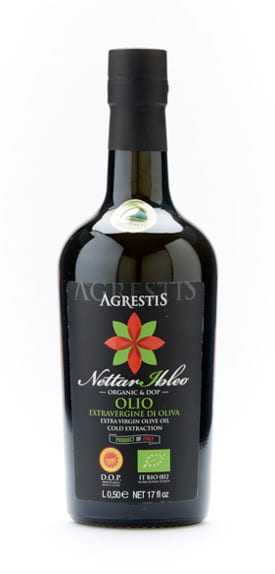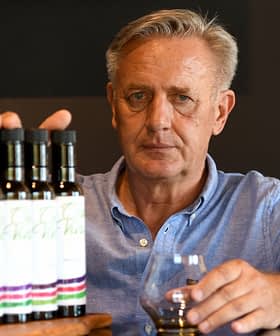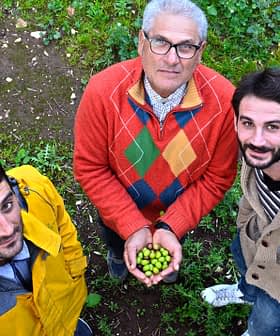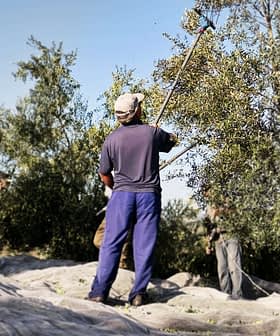We already wrote about the village of Buccheri — a picturesque Sicilian hamlet nestled on the slopes of the Hyblaean mountain range, once part of a submerged volcanic complex — whose economy is mainly based on olive growing and extra virgin olive oil production. Some of the most awarded Italian olive oils of the season hail from the area, including an oil from Azienda Agricola La Tonda (which earned a Gold Award at the 2015 New York International Olive Oil Competition) and the Terraliva farm.
But this year’s top winner in Buccheri, and maybe even in all of Italy, is without a doubt Agrestis. Besides earning a Golden Medal at the Sol D’Oro 2015 competition (with their Fiore d’Oro PDO Monti Iblei) their fantastic Nettaribleo PDO Monti Iblei was declared one of the world’s best organic olive oils at NYIOOC, achieving the Best in Class Award in the medium fruity, monovarietal, organic category.
Nettaribleo, with its intense aroma of grass and medium ripe tomato, is one of the five extra virgin olive oils produced by the farm. Others include the Tonda Iblea organic monocultivar Bell’Omio, the Verd’Olivo intense blend of Moresca, Biancolilla and Verdese and the Foglia d’Argento delicate blend of Tonda Iblea, Carolea, Biancolilla and Nocellara. The farm also produces a number of preserves, sauces and table olives.

NYIOOC Best in Class winner Agrestis Nettaribleo DOP Bio
Giuseppe Nicotra and Lorenzo Paparone, residents of Buccheri and lifelong friends, launched the small cooperative in 2003, to protect the century-old trees growing on the steep lands nearby and to turn the domestic production into a quality business.
Their sons Pietro and Salvatore then joined them, improving the business with their specialized knowledge: Pietro is a 25 year-old, graduate in economics while Salvatore, 22, has almost completed his studies in food technologies.
Meeting those two young farmers in the small square in the heart of Buccheri, by the old fountain framed by olive trees and flowers, gave this writer a sense of relief: a sign that younger generations will be taking care of the olive trees again.
They drove us through the company’s olive groves scattered all around Buccheri’s hills, from the steep terraces of La Stritta (“the narrow”) gorge delimited by traditional dry stone walls to the twisted thousand-year-old trees growing in Sant’Andrea’s plain, also called “the cradle of olives.” The whole area, at an altitude of about 820 meters above sea level, is made of steep hills, beautiful woods, and ravines.
They grow several local varieties but their jewel is the Tonda Iblea, which owes its name to the round (tonda) shape of the olives and to the mountains’ name. “It is an extraordinary variety – Pietro and Salvatore said. “It yields great black table olives and wonderful extra virgin oils with a peculiar tomato scent. It only grows in the Hyblaean area, or rather, it only produces fruits here. And Buccheri olive groves are the best.”
See Also:The World’s Best Olive Oils for 2015
Tonda Iblea’s only issue is in the scarce output: “But quality is unparalleled,” pointed out Salvatore. “Since our fathers decided to aim for quality, we even reduced the output by harvesting the olives earlier, in October. Local growers used to harvest the olives in early December, but we found that harvesting green olives is better, and we strive to achieve the best balance between intensity and roundness, the main features of Tonda Iblea.”
They currently own about 12,000 trees, meaning a hard and continuous work all year long to check every tree’s blossoming stages and to set up the natural traps to prevent fly attacks. Moreover, harvesting is a back breaking job: “Harvest has to be done by hand since tractors can’t go through the terraces. Some olive groves are quite big,” Pietro added, “but others are almost inaccessible and only include a few trees. Every day we have to collect the harvested olives and take them to the mill in Chiaramonte Gulfi as soon as possible, an hour drive from here.”
All those efforts are well rewarded: Agrestis products are excellent, and their quality is achieving worldwide recognition. While they already offer the chance to taste their products during special evenings with a local cook, Nicotra and Paparone are already planning to improve the company’s facilities and set up their own olive-press, to utterly improve their award-winning products.








